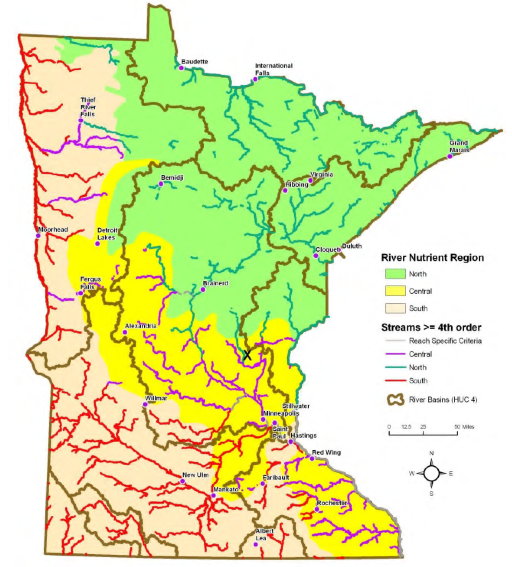State adopts phosphorous standard for MN rivers & streams

The MPCA has established unique river nutrient standards for Minnesotas North, Central, and South eco-regions.
Image: Minnesota Pollution Control Agency
The Minnesota Pollution Control Agency recently approved new, long-overdue standards for excess nutrients (i.e. phosphorous) and algae in Minnesotas rivers and streams. These standards were a priority for Friends of the Mississippi River, and represent an important victory for water quality in Minnesota.
Phosphorus pollution & eutrophication
Phosphorus is a common element in the environment and is essential for plant growth and health. However, excess levels of phosphorus in waters can harm aquatic life and recreation by reducing water clarity, depleting oxygen levels in the water, and causing toxic algae blooms.
River eutrophication is the term scientists use to describe excessive algae growth in waters that have too much phosphorus. Eutrophication can include dangerous blue-green algae blooms, which can severely impair aquatic recreation and even prove fatal to pets.
Monitoring data shows high concentrations of phosphorus in rivers and streams across Minnesota. Over a quarter of monitored rivers and streams exceed the draft river eutrophication criteria for phosphorus. Our 2012 State of the River Report showed that the metro area still sends too much phosphorus down stream to Lake Pepin and beyond.
River eutrophication standards
The U.S. EPA has called on states to develop such nutrient criteria for years, and in 1998 set a goal that all states adopt numeric standards by 2003. While Minnesota failed to meet the deadline, we have had eutrophication standards for lakes in place since 2008.
In developing the newly adopted river eutrophication standards, the MPCA followed a reasonable and well-established scientific approach. The new standards include:
- Eco-region goals: The eco-region approach uses the states natural topography, hydrology, land cover and other factors to determine natural river and stream conditions in different parts of the state. Since water bodies respond to inputs differently in different landscapes, setting standards based on our states eco-regions is the most scientifically sound approach to establishing water quality standards.
- Stressor-response criteria: The standards are not simply phosphorus standards for rivers. The standard will look at both phosphorus levels (called the stressor variable) and response variables like oxygen levels and algae growth. Violations of the standard are not determined by any single factor, but by whether or not excessive phosphorus is causing response variables to harm water quality. There is strong precedent for use of stressor-response criteria, and FMR applauds the States efforts to apply this approach.
- Protection of the Mississippi River and Lake Pepin: The standards take into account the unique features of the Mississippi River and its navigation pools, and will adequately protect these waters. The standards also protect Lake Pepin, a natural lake on the Mississippi River downstream of the Twin Cities that is especially susceptible to eutrophication.
The need for standards
Clear standards are needed to better manage water resources and meet water quality goals. Water quality standards establish pollution limits that protect our water resources for benefits like water recreation, fish consumption and healthy plant communities.
If a water body fails to meet the standards, the state can require pollution reduction from those contributing to the problem and help restore our waters to health. Such standards are essential in evaluating water-monitoring data to determine if waters meet state standards.
In addition, the U.S. EPA has long recognized that the adoption of numeric nutrient water quality criteria would allow for:
- easier and faster identification of impairments and development of clean-up plans;
- quantitative targets to support pollution trading programs;
- easier issuance of protective National Pollutant Discharge Elimination System permits;
- increased effectiveness in evaluating success of nutrient runoff management programs; and
- measurable, objective water quality baselines against which to measure environmental progress.
FMR believes that the adoption of these criteria will provide critical protections to rivers and streams across the state, including the Mississippi River and its tributaries. We congratulate and thank the Minnesota Pollution Control Agency for adopting these standards.
Next steps: While the MPCA Citizens Board has approved the standards, the U.S. EPA must still provide final approval. Final approval is expected to take place during the fall of 2014.
More information & next steps
The Minnesota Pollution Control Agency website has excellent resources for those who wish to learn more about the states new water quality standards for rivers and streams. For more comprehensive information, visit the MPCAs Minnesota Nutrient Criteria Development for Rivers (PDF) document.